Effects of surface charges on phonon properties and thermal conductivity in GaN nanofilms∗
2019-08-16ShuSenYang杨树森YangHou侯阳andLinLiZhu朱林利
Shu-Sen Yang(杨树森), Yang Hou(侯阳), and Lin-Li Zhu(朱林利),†
1Department of Engineering Mechanics,and Key Laboratory of Soft Machines and Smart Devices of Zhejiang Province,Zhejiang University,Hangzhou 310027,China
2School of Naval Architecture and Ocean Engineering,Jiangsu University of Science and Technology,Zhenjiang 212000,China
Keywords: surface charges,GaN nanofilm,elastic model,phonon properties,thermal conductivity
1. Introducti on
Due to the novel properties and wide applications in electronic devices,nanostructured semiconductors have received a great deal of attention in the last decades.[1-4]As the phonon thermal conductivity is one of most important parameters of semiconductor nanostructures, it plays an essential role in investigating the semiconductor nanostructures used in electronic devices to understand the phonon and thermal properties of semiconductor nanostructure comprehensively.[1,5-7]For example, thermoelectric converters require as lower thermal conductivity as possible to improve the thermoelectric conversion efficiency,while nanoelectronic devices require as much higher thermal conductivity as possible for efficient heat dissipation.[8-12]Therefore,the phonon and thermal properties of semiconductor nanostructures have aroused the great interest in the precise design and application of electronic devices.
So far, a lot of researches have focused on the spatiallyconfined phonon properties in semiconductor nanostructure such as the phonon dispersion relation, phonon group velocity and the phonon density of state, as well as the relationship between the phonon thermal conductivity and the phonon properties.[1,13-16]For example, Majumda[17]proposed that the heat transfer induced by lattice vibration or phonon transport in a dielectric film can be treated as a radiation heat transfer on a microscopic scale,and the phonon thermal transfer in the nanofilm satisfies the blackbody radiation law. Balandin et al.[1,13]proposed the phonon engineering and used the elastic model to characterize the phonon properties in semiconductor nanostructures for controlling the thermal and electric properties in these nanostructures.Besides the elastic continuous model and Boltzmann transport approach,[5,16,18-21]firstprinciples and molecular dynamics simulations have also been used to analyze the lattice thermal conductivity of semiconductor nanostructures.[22-26]
The surface/interface effects can also play a significant role in investigating the phonon and thermal properties of semiconductor nanostructures, such as the surface/interface phonon scattering effects and surface/interface stress effects.[18,19,21,27-29]For example, Chen[18]used the Boltzmann transport equation to establish the phonon transport model for the superlattice films by considering different phonon interface scattering modes,and the thermal conductivity of the superlattice films was obtained by numerical calculation.Zhu et al.[19,21,28,29]used the elastic model and the Boltzmann transport approach to explore the influences of surface stress and surface phonon scattering on the phonon properties and phonon thermal conductivity in GaN nanofilms.
The nanostructured components of semiconductor have been widely used in nanoelectronic devices.[3,4,30-33]Most of these nanodevices work in the environment of an elec-tric field,[7,34-38]resulting in the fact that the free charges can appear on the surface of nanostructure. These residual charges can change the surface stress due to the Hellman-Feynman force generated by surface charges, and such an additional surface stress is linearly related to surface charge density.[39-41]The charge-induced surface stress can modify the surface energy, leading to the change of elastic modulus of nanostructures,[42-46]which is related to the phonon properties in semiconductor nanostructure. In this work,we study the influences of surface charges on the phonon properties and thermal properties of GaN nanofilms.
The rest of this paper is organized as follows. In Subsection 2.1, the elastic modulus of nanofilm with surface charges are expressed, and the elastic model is presented to describe the phonon properties of surface charged-nanofilms.The theoretical expression of the phonon thermal conductivity of nanofilm is given in Subsection 2.2. In Subsection 3.1 quantitatively analyzed is the effect of surface charge density on phonon properties of GaN nanofilms, such as phonon dispersion relation, phonon group velocity and phonon density of states. The contribution of surface charges to the phonon thermal conductivity of GaN nanofilm is further discussed in Subsection 3.2. Finally,some conclusions are drawn from the present study in Section 4.
2. Theoretical description
2.1. Elastic model for confined phonons of surface charged nanofilm
When a nanostructure device actually works in an electric field, it is easy to generate surface charges for the nanostructures.The surface charge density will directly affect the equivalent elastic modulus of the nanostructure. This is because the surface stress varies with the change of the surface charge density,and the elastic properties of the nanostructure are sensitive to the surface stress or surface energy.[47]From the theoretical description of confined phonons by continuous elastic model,the change of elastic modulus will affect the phonon properties. Based on the continuum mechanics, the effective elastic modulus tensor of the surface charged-nanostructure can be expressed as[47]

Here, Cijkland Cijklmnrepresent the second-order and thirdorder elastic constants of the material, respectively, D0is the thickness of the nanofilm as shown in Fig.1,Tijand Qijklrepresent the surface elastic tensors associated with the surface elastic properties,and Mijklrefers to the flexibility matrix. For the surface charged-nanofilm, the equivalent elastic constants can be expressed as follows:



Here, the material parameters and the second-order natural elastic modulus constants of GaN are shown in Table 1,where KSandµSrepresent the surface elastic parameters associated with the non-zero term of the second-order elastic modulus of the surface, respectively. The parameter T11is related to the surface stress. When surface charges exist on the surface of nanostructures, surface stress changes with surface charge density linearly,[39-41]namely T11=ζq.Here,ζ is the chargesurface stress coefficient which is generally on the order of 1 V,and q is the surface charge density.
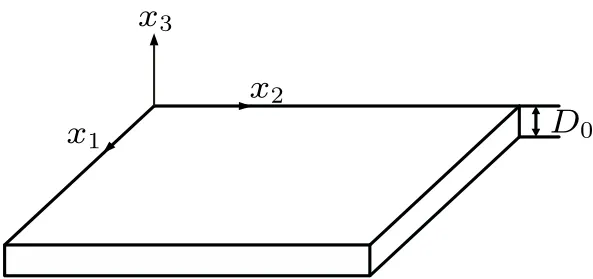
Fig.1. Schematic drawing of GaN nanofilm with surface charges.

Table 1. Elastic parameters of GaN used in calculations.
Since the phonons are related to the vibration of atoms,the elastic model for vibration can be utilized to describe the spatially confined phonons approximately in semiconductor nanostructures.[48-52]Quantization of phonon energy in nanostructures can be achieved based on the elastic model. It has been proved that the elastic model can successfully describe the confined phonons in semiconductor nanostructures.[13,20,53-55]The vibration equation in the elastic model of nanofilm can be expressed as

The boundary conditions are

The displacement solution u of Eq.(3)can be given as

where ω is the phonon frequency, q0is the wave vector, andis the amplitude of the displacement vector. Substituting Eq.(5)into Eq.(3),one can obtain

where

Then, three modes for the phonons in surface chargednanofilms can be obtained. For the shear (SH) mode, the eigenequation of vibration and the corresponding boundary conditions are

For the dilatational (SA) mode and flexural (AS) mode, the eigen equations of vibration and the corresponding boundary conditions are
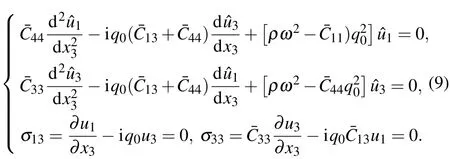
2.2. Phonon thermal conductivity of surface chargednanofilm
After deriving the phonon dispersion relations of surface charged nanofilm in the different modes,the phonon frequency can be numerically calculated by using the finite element method with phonon wave vector q0. Then,the phonon group velocity with a given phonon mode number n can also be achieved numerically

where,ωnand q0respectively represent the phonon frequency and phonon wave vector for a given phonon mode number n. From the Callway model of a single average-polarized phonon,the average phonon group velocity ¯V associated with the phonon frequency can be derived and given as

Here, the superscript indicates the corresponding phonon mode type, the subscript n represents a given phonon mode number, and m represents the total phonon branch number.The quasi-two-dimensional phonon density of states for a given phonon mode number can be calculated from the phonon dispersion relation and phonon group velocity existing in the nanofilm,and given as follows:

Here, H is the thickness of the nanofilm. The total phonon density can be obtained by the superposition of three modes of phonons

Based on these expressions for phonon dispersion relationship,the phonon average group velocity and the phonon density of state,the phonon thermal conductivity of the surface chargednanofilm can be expressed as[27,55]

Here, h= ¯h/2π, ¯h is the Planck constant, x=ħωn(q0)/kBT.τ is the total relaxation time, given asin which several scattering mechanisms are involved,including Umklapp scattering rate τU, point-defect scattering rate τM,and acoustic phonon-electron scattering rate.[16,20,29]Since the main objective of this work is to study the influences of surface charges on the phonon and thermal properties in spatially confined nanofilm, it is assumed that the surface of nanofilm is smooth enough to ignore the boundary scattering mechanism in the phonon scattering process. In Eq. (14), κ0is the phonon thermal conductivity of bulk material, and G1is the proportional coefficient with respect to the bulk thermal conductivity of the material κ0.
3. Simulation results and discussion
3.1. Phonon properties of surface charged-GaN nanofilm
As mentioned above,we use the finite difference method to calculate the phonon dispersion relationships of surface charged-GaN nanofilm under different modes. Here, the surface charge densities are taken as-10 C/m2,0,and 10 C/m2.The other parameters in scattering time are adopted from the literature.[48-51]For simplicity, the SH mode is taken for example to explore the influences of surface charges on the phonon properties and thermal properties of GaN nanofilms.Figure 2 shows the phonon dispersion relationship of nanofilm under different surface charge densities for the SH mode. It can be seen intuitively from the figure that when the phonon energy is the cutoff energy(q0=0),the surface charges have no contribution to the phonon energy. As the phonon wave vector increases,the influence of surface charge becomes more and more significant. It can also be found from Fig. 2 that the negative surface charge causes the slope of each curve to increase, while the positive surface charge makes the slope decrease. In other words, negative surface charges increase the phonon energy, while positive surface charges reduce the phonon energy.

Fig.2. Variations of phonon energy with surface charge density for SH mode in GaN nanofilms with different surface charge densities.
After the phonon dispersion relationship is determined,the phonon average group velocity can be calculated based on Eqs.(10)and(11). Figure 3 shows the phonon average group velocity of GaN nanofilm for SH mode as a function of phonon energy at different surface charge densities. When the phonon energy is small,the phonon average group velocity is roughly equivalent to the phonon group velocity.As the phonon energy increases, the phonon group velocity begins to oscillate continuously. Interestingly,the oscillation behavior of the phonon average group velocity has no change in the presence of surface charges. However, the surface charge has a significant effect on the phonon average group velocity of phonons. That is, the negative surface charges increase the velocity and the positive surface charges reduce the velocity.
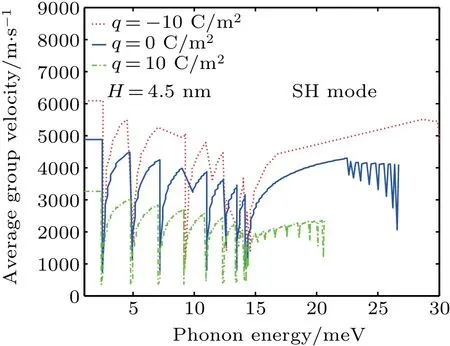
Fig. 3. Plots of phonon average group velocity versus phonon energy for SH mode in GaN nanofilms with different surface charge densities.
Figure 4 displays the phonon density of states for SH mode varying with phonon energy for three different surface charge densities. It can be found that as the phonon energy increases, the phonon density of states also increases stepwise,and then begins to fall after reaching the peak value. In addition, it can also be found that the surface charge density can significantly change the phonon density of states. That is,the positive surface charges increase the density of states and the negative surface charges reduce the phonon density of state.
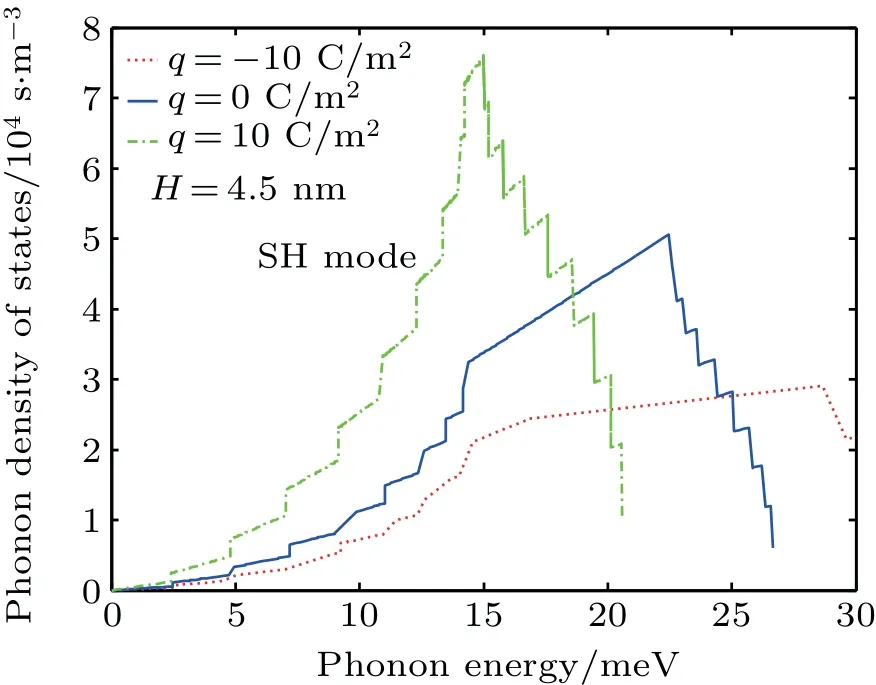
Fig. 4. Variations of phonon density of states with phonon energy for SH mode in GaN nanofilms with different surface charge densities.
3.2. Phonon thermal conductivity of surface charged nanofilm
When the phonon dispersion relations and phonon group velocities are achieved, one can calculate the various scattering rates under different surface/interface stresses, including Umklapp scattering rate, point-defect scattering rate, and phonon-electron scattering rate, which are shown in Fig. 5.Obviously,the Umklaap scattering rate is dominant for the low phonon,which is significantly higher than the other two scattering rates. The point-defect scattering becomes dominant with the increase of frequency. One can also find that the surface charges can change the point-defect scattering rate and phonon-electron scattering rate, but the Umklaap scattering rate is almost independent of the surface charges.

Fig. 5. Variations of scattering ratewith phonon frequency in GaN nanofilms with different surface charge densities.
According to the expression of phonon thermal conductivity in Eq.(14),the effect of surface charges on the phonon thermal conductivity of GaN nanofilm can be investigated quantitatively through combing the phonon average group velocity, phonon density of state, and scattering rates obtained above. Firstly, the variations of phonon thermal conductivity of GaN nanofilm with temperature for three different surface charge densities are plotted in Fig.6. It can be seen from the figure that for each surface charge density,as temperature increases the phonon thermal conductivity is first enhanced and then reaches the maximum value. With further increasing the temperature,the thermal conductivity decreases. One can also find that the negative surface charges enhance the temperature dependence of phonon thermal conductivity while the positive surface charges weaken the sensitivity of temperature to the thermal conductivity. In addition,the influence of surface charges on the phonon thermal conductivity of GaN nanofilm turns weaker for the higher temperature.

Fig.6. Plots of phonon thermal conductivity versus temperature for SH mode in GaN naonfilms with different surface charge densities.
Figure 7 shows the variations of phonon thermal conductivity with the thickness of GaN nanofilm for three different surface charge densities. As can be seen from the figure,the negative charges increase the phonon thermal conductivity and the positive charges reduce the phonon thermal conductivity. It is interesting to notice that when the surface of the nanofilm presents negative charges with a density of 10 C/m2,the phonon thermal conductivity is first enhanced with increasing the thickness of nanofilm, and then begins to decrease slightly and eventually tends to be flat.It is because the surface charge-related elastic modulus of nanofilm is size-dependent,and the negative charges also weaken the size effect on elastic modulus.[43,44]For the smaller thickness of nanofilm, the surface charges weaken the size dependence of elastic modulus more significantly than that of thermal conductivity. In the case of positive surface charges, the phonon thermal conductivity of GaN nanofilm is improved gradually with increasing the thickness of nanofilm and then the curve tends to be flat.Such a size effect of phonon thermal conductivity of nanofilm comes from the quantum confinement effect of phonons in nanofilm. One can also note that the positive surface charges make the size effect of thermal conductivity more significant,while the negative surface charges weaken the size effect of conductivity.
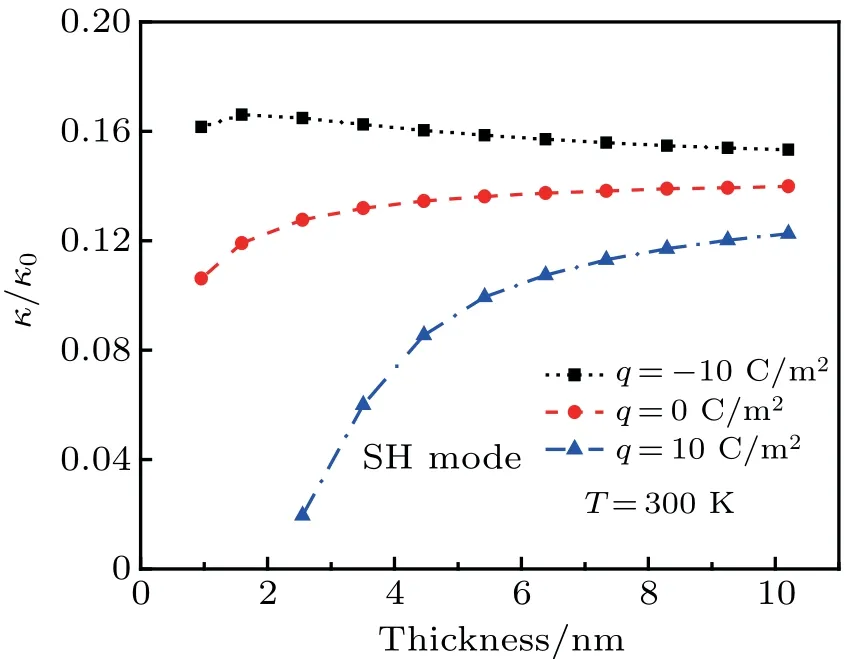
Fig. 7. Plots of phonon thermal conductivity versus thickness for SH mode in GaN nanoflims with different surface charge densities.
Figure 8 shows the variations of phonon thermal conductivity with surface charge density for three different thickness values. It can be noted that when the surface charge density changes from a positive value to a negative value,the phonon thermal conductivity increases monotonically for each thickness value. It can be clearly found that the positive surface charges reduce the phonon thermal conductivity and the negative surface charges increase the phonon thermal conductivity.Meanwhile,when the surface of the nanofilm presents the negative charges with the density greater than 3 C/m2,the phonon thermal conductivity decreases slightly as the thickness of the nanofilm increases.When the surface charge density is greater than-3 C/m2,the phonon thermal conductivity increases with the increase of the thickness of the nano-film,which is consistent with the results obtained in Fig.6. It can be seen that the negative surface charges make much less contribution to the thermal conductivity than the positive surface charges.
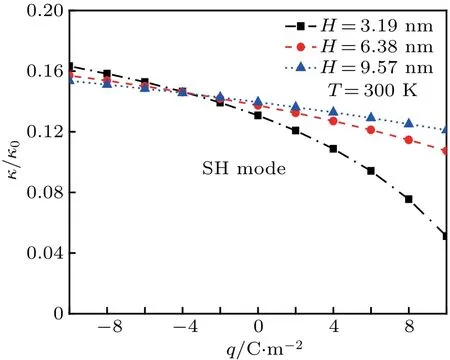
Fig.8. Variations of phonon thermal conductivity with surface charge density for SH mode in GaN nanofilms with different thickness values.
4. Conclusions
In this work,the effects of surface charges on the phonon and thermal properties have been investigated theoretically.The surface charges modify the elastic constants in nanostructures,leading to the change of phonon properties of semiconductor nanofilms. The elastic model is used to describe the phonon properties of surface charged-GaN nanofilms. Then,the phonon dispersion relation,the phonon average group velocity,and the phonon density of states for the surface charged-GaN nanofilms are simulated. Finally, the effects of surface charges on the phonon thermal conductivity of GaN nanofilms with different temperatures and film thickness values are analyzed. The numerical results demonstrate that when the surface charges can significantly modify the phonon properties and phonon thermal conductivity, these surface charges can also change the temperature and size dependence of the phonon thermal conductivity. This work will be helpful in adjusting and controlling the phonon properties and thermal conductivity in nanostructured components and nanodevices by changing the surface charges.
猜你喜欢
杂志排行
Chinese Physics B的其它文章
- Exploring alkylthiol additives in PBDB-T:ITIC blended active layers for solar cell applications∗
- Study on the nitridation of β-Ga2O3 films∗
- Thin-film growth behavior of non-planar vanadium oxidephthalocyanine∗
- Monolithic semi-polar(1¯101)InGaN/GaN near white light-emitting diodes on micro-striped Si(100)substrate∗
- Spectral properties of Pr:CNGG crystals grown by micro-pulling-down method∗
- Quaternary antiferromagnetic Ba2BiFeS5 with isolated FeS4 tetrahedra
